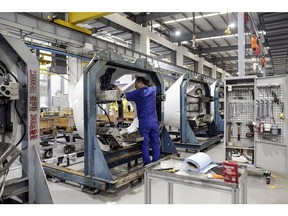China’s factory activity unexpectedly contracted in July while property sales continued to shrink, highlighting the fragility of the economy’s recovery amid sporadic Covid outbreaks and adding to calls for more policy stimulus to fuel growth.

Article content
(Bloomberg) — China’s factory activity unexpectedly contracted in July while property sales continued to shrink, highlighting the fragility of the economy’s recovery amid sporadic Covid outbreaks and adding to calls for more policy stimulus to fuel growth.
Advertisement 2
Article content
The official manufacturing purchasing managers index fell to 49 from 50.2 in June, the National Bureau of Statistics said Sunday, dropping below the 50-mark that indicates a contraction in activity. Separately, data from China’s top 100 property developers showed the housing market continued to slump last month.
The economy’s recovery remains fragile as the government sticks to its strict Covid Zero approach of tightening restrictions when virus outbreaks occur. A recent flareup in the southern manufacturing hub of Shenzhen impacted factory operations there, raising concerns about disruptions to global supply chains.
GDP growth in the second quarter was the slowest since the initial Wuhan outbreak, and economists expect full-year expansion could reach just 4% or below this year. With the property market continuing to weigh on the growth outlook, economists say the need for more policy stimulus remains strong.
Advertisement 3
Article content
The Communist Party’s top decision makers last week signaled a softening on the government’s growth target of around 5.5%, although they failed to announce any new stimulus policies to boost the recovery.
Citigroup Inc. economists including Yu Xiangrong wrote in a note that the property market and fiscal policy are the top two venues for stimulus in the coming months. The government has also sped up infrastructure spending to help spur growth in the second half.
The PMI data showed the sluggishness in manufacturing was broad-based, with activity among large, medium and small sizes all contracting. The non-manufacturing PMI, which measures activity in the construction and services sectors, continued to expand, although at a weaker pace.
Advertisement 4
Article content
The NBS cited various reasons for the slide in manufacturing, including seasonal factors and a drop in high-energy consuming industries. New orders and new export orders for both manufacturing and non-manufacturing all contracted in July.
“Insufficient market demand is the main difficulty faced by manufacturing enterprises at present, and the foundation for the recovery of manufacturing industry needs to be consolidated,” the bureau said in a statement.
What Bloomberg Economics Says…
China’s recovery is sputtering after only a short spurt in the wake of Shanghai’s reopening. A surprise drop in July’s official manufacturing PMI into contraction more than reversed June’s rise — underlining an abrupt loss of momentum. Scattered Covid-19 outbreaks and fresh strains in the property sector are clearly taking a toll on the economy.
Chang Shu and David Qu
For the full report, click here
The housing market continues to weigh on China’s outlook. Sales at China’s top 100 developers fell 39.7% from a year earlier, only narrowing slightly from a drop of 43% in the previous month, according to data released by China Real Estate Information Corp.
“The challenges to China’s GDP growth in the third quarter could be bigger than expected earlier,” Bruce Pang, chief economist at Jones Lang LaSalle Inc., said Sunday.
(Updates with additional details throughout.)
Advertisement
Stay connected with us on social media platform for instant update click here to join our Twitter, & Facebook
We are now on Telegram. Click here to join our channel (@TechiUpdate) and stay updated with the latest Technology headlines.
For all the latest Business News Click Here
For the latest news and updates, follow us on Google News.

